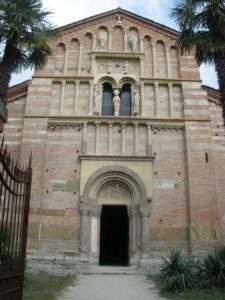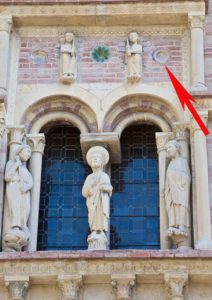 “There is a history in all men’s lives,
“There is a history in all men’s lives,
Figuring the nature of the times deceased;
The which observed, a man may prophesy,
With a near aim, of the main chance of things
As yet not come to life, which in their seeds
And weak beginnings lie intreasured.
Such things become the hatch and brood of time”
(King Henry IV, part 2, act 3, sc. 1)
There is a history in all men’s lives as well as in their works and, in particular, works of art.
Case in point is the Medieval Abbey of Vezzolano (Italy) and a particular detail of which I will tell you later in this article.
It has been said that the fascination with the Middle Ages has something to do with our own childhood. Those strange faces as shown in paintings and book miniatures, with mesmerizing and yet naïve expressions – those characters often crowded against one another without concern for perspective and yet illuminated with a magnificent combination of colors, they are images that could spring from the imagination of a child
The Middle Ages have forged the landscape of Europe and have given names to places and people. At the far edge of our collective memory we can imagine the rhythms of ancient jobs and of days bygone, the religious and social rites that, in times past, gave a meaning to life.
Holding the secrets of an intimate identity which eludes us, the Middle Ages are a kind of screen for our dreams. It was an age when the rural world was king, an age of nightmares, barbaric, obscure, filled with abysmal superstition, weighed by the rudest dominations, before the Renaissance came to dissipate the darkness with the light of reason and the illumination provided by a revived antiquity.
Still, an age of angels and devils, often consorting together as depicted or sculpted in the capitals of churches, cathedrals and abbeys. An age of dreams too beautiful to be true, a historic utopia that some marginalized and rejected people of today envision as a Golden time – before the bourgeoisie, the State and the Industrial Revolution imposed their iron rules and took enchantment out of the world.
 But let’s return to the Abbey of Vezzolano. Sometimes a detail, overlooked in the context of general knowledge, can cast a different light on our collective view of history.
But let’s return to the Abbey of Vezzolano. Sometimes a detail, overlooked in the context of general knowledge, can cast a different light on our collective view of history.
For the Medieval western world the Muslims were infidels, or so were defined by the Church – a characterization that justified the four Crusades, much as the “war on terror” justifies the American occupation of lands and people who could not hurt America even if they wanted to.
Therefore the following detail will perhaps be a surprise for some. In the façade of the Abbey of Vezzolano, among other decorations, there are three ceramic roses or circles or basins. In the one on the right hand  side, as pointed by the arrow and enlarged in this adjacent image, there are inscribed – three times and in Arabic – the names of Allah and Muhammad.
side, as pointed by the arrow and enlarged in this adjacent image, there are inscribed – three times and in Arabic – the names of Allah and Muhammad.
This is not the only instance. In an Abbey in the Tuscan town of Cascia there is a famous triptych attributed to the Medieval painter Masaccio. In the halo of the Virgin Mary there is inscribed (in Arabic and in reverse) the “shahada”, the Muslim declaration of faith, “There is no other God but Allah”.
Very likely, Masaccio and the artist who decorated the Abbey of Vezzolano were struck by the inherent artistic beauty of the Arabic script. Calligraphy was (and still is) a revered art in the Muslim world. In fact one of the effects of the invasion of Iraq to find the nonexistent “weapons of mass destruction” was the assassination in Baghdad of Khal-al-Zahawi, considered the “Prince of Calligraphers”, in the art of writing classical Arabic characters.
All in all, the reader may agree that there is a history not only in all men’s lives but also in most things of interest.
In the play. Warwick meditates on a prediction by King Richard II. Northumberland had helped Bolingbroke take over the crown. Richard II predicted that the same Northumberland would betray the new king. ‘Main’ here means ‘general’.
